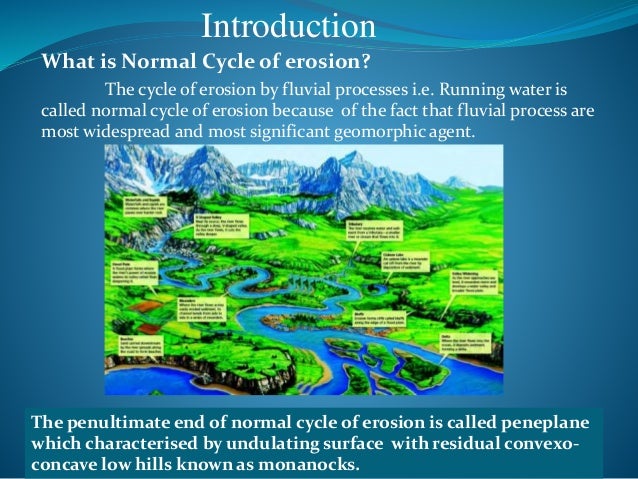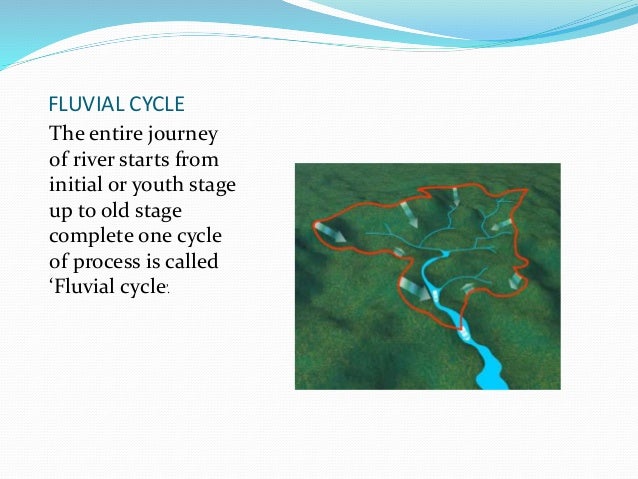Landforms and Cycle of Erosion: Fluvial Landforms and Cycle of Erosion
Relevance: Prelims/Mains: G.S paper I: Physical Geography

Fluvial Landforms and Cycle of Erosion

- The landforms created as a result of degradational action (erosion) or aggradational work (deposition) of running water are called fluvial landforms.
- The fluvial processes may be divided into three physical phases – erosion, transportation and deposition.
- The depositional action of a stream is influenced by stream velocity and the volume of river load.
- The decrease in stream velocity reduces the transporting power of the streams which are forced to leave some load to settle down.
- Increase in river load is effected through accelerated rate of erosion in the source catchment areas consequent upon deforestation.
- Various landforms resulting from fluvial deposition are as follows:
Alluvial Fans and Cones
- When a stream leaves the mountains and comes down to the plains, its velocity decreases due to a lower gradient.
- As a result, it sheds a lot of material, which it had been carrying from the mountains, at the foothills.
- This deposited material acquires a conical shape and appears as a series of continuous fans. These are called alluvial fans.
- Such fans appear throughout the Himalayan foothills in the north Indian plains.
Natural Levees
These are narrow ridges of low height on both sides of a river, formed due to deposition action of the stream, appearing as natural embankments.
These act as a natural protection against floods but a breach in a levee causes sudden floods in adjoining areas, as it happens in the case of the Hwang Ho river of China.
Delta
- A delta is a tract of alluvium at the mouth of a river where it deposits more material than can be carried away.
- The river gets divided into distributaries which may further divide and rejoin to form a network of channels.
A delta is formed by a combination of two processes:
- load-bearing capacity of a river is reduced as a result of the check to its speed as it enters a sea or lake, and
- clay particles carried in suspension in the river coagulatein the presence of salt water and are deposited.
- The finest particles are carried farthest to accumulate as bottom-set beds.
- Depending on the conditions under which they are formed, deltas can be of many types.
Arcuate or Fan-shaped
This type of delta results when light depositions give rise to shallow, shifting distributaries and a general fan-shaped profile. Examples: Nile, Ganga, Indus.
Bird’s Foot Delta
- This type of delta emerges when limestone sediment deposits do not allow downward seepage of water.
- The distributaries seem to be flowing over projections of these deposits which appear as a bird’s foot.
- The currents and tides are weak in such areas and the number of distributaries lesser as compared to an arcuate delta. Example: Mississippi river.
Estuaries
Sometimes the mouth of the river appears to be submerged. This may be due to a drowned valley because of a rise in sea level.
Here fresh water and the saline water get mixed. When the river starts ‘filling its mouth’ with sediments, mud bars, marshes and plains seem to be developing in it.
These are ideal sites for fisheries, ports and industries because estuaries provide access to deep water, especially if protected from currents and tides. Example: Hudson estuary.
Cuspate Delta
- This is a pointed delta formed generally along strong coasts and is subjected to strong wave action. There are very few or no distributaries in a cuspate delta.
- Example: Tiber river on west coast of Italy.
For more such notes, Articles, News & Views Join our Telegram Channel.
Click the link below to see the details about the UPSC –Civils courses offered by Triumph IAS. https://triumphias.com/pages-all-courses.php

